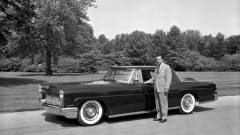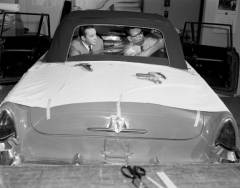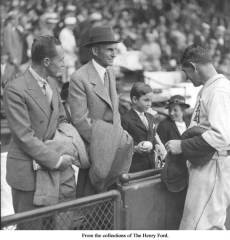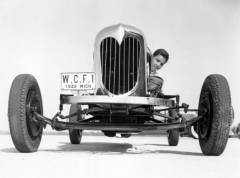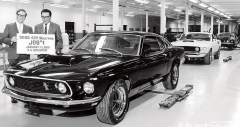-
Posts
211 -
Joined
-
Last visited
Recent Profile Visitors
3,102 profile views
Blue Oval Staff's Achievements
4
Reputation
-

Ford told Settles they are not going back to the table....
Blue Oval Staff replied to Tier2's topic in Ford Employee Forum
Debating is cool here - name calling isn't. Keep it clean. -
Tesla to raise capital for e-car, energy projects Tesla Motors announced Thursday it was planning to sell 2.1 million new shares in hopes of raising about $500 million (450 million euros). Tesla said it imagined the shares would be sold at Wednesday's closing price of $238.17. Chief Executive Elon Musk would be ready to buy nearly 84,000 shares for about $20 million in the offering, according to a company statement. Musk is already the company's largest shareholder with a 22.25 percent stake. He intends to use the fresh cash to boost the development of Tesla's energy business, its upcoming Model 3 project and its Gigafactory battery manufacturer. Book-running managers for the offering included Goldman Sachs, Morgan Stanley, JPMorgan and Deutsche Bank Securities. Tesla burns cash The offering comes a week after Tesla reported a huge loss in the second quarter. The Silicon Valley-based e-car maker delivered 11,532 cars in the second period and said it had an operating loss of about $47 million, meaning a loss of $4,000 on every car it sold. http://www.dw.com/en/tesla-to-raise-capital-for-e-car-energy-projects/a-18648121
-

William Clay Ford with 1956 Lincoln Continental Mark II
Blue Oval Staff posted a gallery image in People & Places
-
-
-
-
-
-
-
FORD MUSTANG GIUGIARO The 2005 Ford Mustang captured the hearts and minds of millions of fans and future owners when the all-new model debuted. But the proportions and design of Ford’s first purpose-built muscle car in 30-plus years caught the eyes and sparked the imaginations of a pair of the world’s leading coachbuilders in Italy as well. “When we saw the new Mustang, we knew two things: It was the best we’d seen since the original, and we had to get our hands on one,†said Fabrizio Giugiaro, styling director of Italdesign – Giugiaro S.P.A. “We still believe it’s important to show the automotive world pure exercises in style that interpret key models reflecting the history and image of important brands.†So in early 2005, Giugiaro pitched J Mays, Ford Motor Company’s group vice president, Design and chief creative officer, on his idea to do an Italian job on the beloved Mustang. The result: Mustang by Giugiaro – a one-of-a-kind concept powered by Ford Racing technologies, marking the Italian coachbuilder’s first reveal at the inaugural November Los Angeles Auto Show. “It seemed only fitting,†said Mays. “This design study reinforces the global appeal of Mustang, yet it’s right at home in L.A. – America’s most enthusiastic performance and muscle car market. Plus, design icon Giorgetto Giugairo’s offer to work his magic on Mustang alongside his son underscores the timelessness allure of Ford’s most iconic car.†Design aficionados will remember that the senior Giugiaro – who last year celebrated his 50 th anniversary in the business by designing a custom-made Ferrari, the GG50 – created the 1965 Bertone Mustang. The car, which was unmistakably Italian in its interpretation, became the first European-styled car to make its international debut in America following the end of World War II. The senior Giugiaro’s portfolio includes concept and production designs for nearly every automaker in the world – from Fiat, Alfa Romeo and Volkswagen to Mazda, Lotus and Bugatti. Since joining ItalDesign, the family firm, in 1990, Fabrizio Giugiaro has helped deliver key global designs as well, but American automotive icons have long captured his attention. Click here for more photos! He designed the Chevrolet Corvette Moray, unveiled in early 2003, and was eager to expand the collection of Giugiaro-interpreted American metal. Fabrizio Giugiaro led the 2-D design process on the Mustang by Giugiaro concept, allowing him to deliver a complete exterior model from the family’s Turin, Italy, studios in just four months. Visually, the Mustang by Giugiaro appears more compact than the production car, thanks to a reduction of the rear overhang and a signature Giugiaro “trick†of tapering the angles on the car to the limit of its mechanical outlines. Still, the Italian version of America’s most popular muscle car hasn’t lost any of its swagger The vibrant orange concept is wider than the production version. The Giugiaros added 30 millimeters to the front, gradually expanding the width by a full 80 millimeters toward the rear, which is typical in Italian design. With its longer hood and the trunk barely visible, the car looks more of a fastback in side view. But details throughout reinforce the freedom and rebellion synonymous with Mustang. Fabrizio Giugiaro’s favorites include: * The interior – featuring a dramatic instrument panel that sweeps the width of the car; circular gauges that project from behind the steering wheel; dark brown horsehide-covered headrests with horse logo accents; and seat cushions and backrests elaborately upholstered in dark brown mottled horse hides. * The single curved glass panel that bridges the windshield and rear window, serving as the concept’s roof. Produced by Solutia of Detroit, the panel is made from a special type of crystal that filters out 100 percent of UVA rays while providing unfettered vista views. * Its dramatic doors, which are hinged at the base of the upright A-pillar and open vertically at the touch of a button. * Bespoke taillights, which are three separate elements as found on the 1964 Mustang – but reinterpreted into a more dramatic arrow shape that links to the louver panels that replace the rear side windows. * The visible curl that sweeps into the crest of the concept’s carbon fiber fenders, hinting at tail fins that defined American cars of the ‘50s. * The sporting-but-elegant unique 20-inch rims, fitted with 275/40 tires on the front and larger 315/35 tires on the rear. As its wheels and tires suggest, the Mustang by Giugiaro is more than just a tribute to Mustang design. It also is an exclamation of the car’s heritage of performance. The concept features a powertrain and chassis enhanced in conjunction with Ford Racing – which is responsible for Ford Motor Company motorsports development and operations. Ford Racing’s efforts include the development and sale of a race-prepared version of the Mustang, called the FR500C, for the Grand-Am KONI Challenge Series. In its first season alone, the FR500C scored five wins in the 2005 GS Class, including the manufacturers’ championship, in which Mustang bested other production-based sports cars, including the BMW M3 and Porsche 911. This Mustang, a turn-key race car sold to privateers, provided the inspiration for the Mustang by Giugiaro concept’s performance and handling attributes. Ford Racing improved on the already-robust 300 horsepower all-aluminum 4.6-liter 3-valve V-8 engine in the production Mustang GT by adding an intercooled twin-screw supercharger for the new concept. Additional improvements include fuel injectors from the Ford GT and a unique engine calibration. Engine air intake is increased with a larger 95 mm mass air meter and a conical air filter. Exhaust performance is enhanced with new Ford Racing mufflers and an X-pipe. The powertrain upgrades deliver an estimated 500 horsepower, complete with a boost level of 11 psi from the Ford Racing supercharger. A high-efficiency Ford Racing aluminum radiator provides increased cooling capability to accompany the extra 200 horsepower provided under hood. Under the car, the FR500C-inspired chassis tuning is accomplished with a tailored Ford Racing Handling Pack. This package, available through Ford Racing for the Mustang GT, adds new Dynamic-tuned dampers, lowering springs and anti-sway bars. The changes give the car a lower stance while sharpening handling response. The car rides approximately 1.5 inches lower than the production Mustang GT. “The Mustang by Giugiaro drives as good as it looks,†said Fabrizio Giugiaro. “After taking it to the limits on streets outside of Turin, I can honestly say this car was well worth the 30,000 hours of blood, sweat and tears that we invested to create a modern performance classic.â€
-
MORE IMAGES AND TEXT HERE.
-
Ford Edge All Wheel Drive Ford Motor Company experts clear the air on all-wheel drive vs. four-wheel drive With the addition of the all-wheel-drive (AWD) Ford Fusion and Mercury Milan, Ford Motor Company is now offering affordable AWD technology to a whole new group of customers, bringing it to one of the largest volume segments in the industry. Many of these new customers may wonder why they need AWD on their midsize sedan, especially if they live in a climate where the roads are never icy or snow covered. “Many people think about the AWD system on the Ford Edge the same way they think of the four-wheel-drive (4WD) system on their F-150,†says Ashok Rodrigues, 4WD technical specialist for Ford Motor Company. “There’s been a lot of confusion in the industry as to how manufacturers use the terms 4WD and AWD.†Rodrigues says there are three basic types of AWD/4WD systems, regardless of whether they’re based on front-drive or rear-drive vehicles. Those are part-time, center differential and on-demand. Part-Time Four-Wheel Drive Part-time systems are what most people commonly think of as 4WD. These rugged, traditional systems, found on trucks including the F-150 and Super Duty, feature a simple lock and unlock mechanism that locks the front wheels to the rear wheels. Four-wheel drive is engaged by the vehicle’s operator, usually by flipping a switch or pushing a button on the dash. Part-time systems are almost always marketed with a low-range gear that’s used when maximum torque is needed, for such activities as extreme off-roading or for moving a heavy object. “It’s pretty much a black or white operation,†says Rodrigues. “You either want four-wheel drive or you don’t.†The benefits of this system are its ruggedness and the fact that it’s inexpensive. Four-wheel-drive vehicles are at their best pulling a boat out of the water or hauling a Bobcat back in the woods. The downside is that the system isn’t really adaptable to everyday driving. “With a part-time system, you will inherently bind up when you go around corners,†says Rodrigues. “When cornering, the front wheels want to track a wider arc than the rear wheels. Because all four wheels are locked together physically, you simply can’t do that with part time. It is an inherent part of the design and is fully intended.†Center Differential The V-6 Mercury Mountaineer uses a center differential that constantly splits torque 40 percent to the front wheels and 60 percent to the rear wheels. Unlike the part-time system, the wheels themselves turn at different speeds, eliminating the binding that part-time systems exhibit when cornering. Center differentials need some sort of clutch or limited-slip mechanism to control slip. For example, when the rear wheels begin to slip, the clutch mechanism applies brake torque to the rear axle, sending drive torque to the front axle and keeping the vehicle moving forward. Rodrigues says that traction control can also serve as the clutching mechanism, providing a cost-effective means of applying brakes to the spinning axle. “The nice thing about a center differential is that it’s always sending that torque,†he says, “so you have a very nice refined driving performance. Some people really like those kinds of systems. But they can be heavy, expensive and, as the devices are generally purely mechanical, there simply aren't many tuning options.†On-Demand All-Wheel Drive The third type is the on-demand system. An on-demand system is always driving one axle and then drives the other axle as conditions demand. In the case of the Ford Fusion or Ford Edge, the front axle is the primary drive axle. For the Ford Explorer and Mercury Mountaineer, the rear axle is the primary drive axle. Simple mechanical systems use a clutch to send torque to the secondary drive axle when the primary axle starts to slip. Today’s electronic systems — like those found on all Ford Motor Company cars as well as Ford Explorer and Expedition, the Lincoln Navigator and the V-8 Mercury Mountaineer — use a computer controller that monitors such things as steering angle, accelerator pedal position and engine speed to provide the precise amount of torque, front to rear, as needed. “What’s really impressive about these systems is that they don’t just react to slip,†says Rodrigues. “They usually prevent that slip from occurring in the first place. By predicting slip and preventing it, the driver doesn’t feel the vehicle slipping and responding. The operation is seamless.†He says on-demand systems create a smooth, confident driving feel in all weather conditions with much better traction. The systems also help balance and improve driving dynamics by sending torque to the secondary axle when it’s most appropriate for handling. “On a normal front-drive vehicle, the front wheels have a limited amount of traction available to them,†says Rodrigues. “That traction has to be used for moving the car forward and for steering. If you use all of the torque to drive forward, you don’t have anything left to steer with, and vise versa. An AWD system off-loads some of that drive torque to the rear wheels. The harder you accelerate, the more of that torque that’s going to be redirected to the rear wheels, restoring the ability of the front wheels to steer the vehicle while providing an even higher level of acceleration.†But he cautions that while these sophisticated AWD systems do help with acceleration, they won’t make the car stop any faster. “Your traction is much better and your handling is much better,†says Rodrigues, “but AWD does not give you more braking power.â€
-
Ford Fusion, Milan, MKZ All Wheel Drive Ford Motor Company experts clear the air on all-wheel drive vs. four-wheel drive With the addition of the all-wheel-drive (AWD) Ford Fusion and Mercury Milan, Ford Motor Company is now offering affordable AWD technology to a whole new group of customers, bringing it to one of the largest volume segments in the industry. Many of these new customers may wonder why they need AWD on their midsize sedan, especially if they live in a climate where the roads are never icy or snow covered. “Many people think about the AWD system on the Ford Edge the same way they think of the four-wheel-drive (4WD) system on their F-150,†says Ashok Rodrigues, 4WD technical specialist for Ford Motor Company. “There’s been a lot of confusion in the industry as to how manufacturers use the terms 4WD and AWD.†Rodrigues says there are three basic types of AWD/4WD systems, regardless of whether they’re based on front-drive or rear-drive vehicles. Those are part-time, center differential and on-demand. Part-Time Four-Wheel Drive Part-time systems are what most people commonly think of as 4WD. These rugged, traditional systems, found on trucks including the F-150 and Super Duty, feature a simple lock and unlock mechanism that locks the front wheels to the rear wheels. Four-wheel drive is engaged by the vehicle’s operator, usually by flipping a switch or pushing a button on the dash. Part-time systems are almost always marketed with a low-range gear that’s used when maximum torque is needed, for such activities as extreme off-roading or for moving a heavy object. “It’s pretty much a black or white operation,†says Rodrigues. “You either want four-wheel drive or you don’t.†The benefits of this system are its ruggedness and the fact that it’s inexpensive. Four-wheel-drive vehicles are at their best pulling a boat out of the water or hauling a Bobcat back in the woods. The downside is that the system isn’t really adaptable to everyday driving. “With a part-time system, you will inherently bind up when you go around corners,†says Rodrigues. “When cornering, the front wheels want to track a wider arc than the rear wheels. Because all four wheels are locked together physically, you simply can’t do that with part time. It is an inherent part of the design and is fully intended.†Center Differential The V-6 Mercury Mountaineer uses a center differential that constantly splits torque 40 percent to the front wheels and 60 percent to the rear wheels. Unlike the part-time system, the wheels themselves turn at different speeds, eliminating the binding that part-time systems exhibit when cornering. Center differentials need some sort of clutch or limited-slip mechanism to control slip. For example, when the rear wheels begin to slip, the clutch mechanism applies brake torque to the rear axle, sending drive torque to the front axle and keeping the vehicle moving forward. Rodrigues says that traction control can also serve as the clutching mechanism, providing a cost-effective means of applying brakes to the spinning axle. “The nice thing about a center differential is that it’s always sending that torque,†he says, “so you have a very nice refined driving performance. Some people really like those kinds of systems. But they can be heavy, expensive and, as the devices are generally purely mechanical, there simply aren't many tuning options.†On-Demand All-Wheel Drive The third type is the on-demand system. An on-demand system is always driving one axle and then drives the other axle as conditions demand. In the case of the Ford Fusion or Ford Edge, the front axle is the primary drive axle. For the Ford Explorer and Mercury Mountaineer, the rear axle is the primary drive axle. Simple mechanical systems use a clutch to send torque to the secondary drive axle when the primary axle starts to slip. Today’s electronic systems — like those found on all Ford Motor Company cars as well as Ford Explorer and Expedition, the Lincoln Navigator and the V-8 Mercury Mountaineer — use a computer controller that monitors such things as steering angle, accelerator pedal position and engine speed to provide the precise amount of torque, front to rear, as needed. “What’s really impressive about these systems is that they don’t just react to slip,†says Rodrigues. “They usually prevent that slip from occurring in the first place. By predicting slip and preventing it, the driver doesn’t feel the vehicle slipping and responding. The operation is seamless.†He says on-demand systems create a smooth, confident driving feel in all weather conditions with much better traction. The systems also help balance and improve driving dynamics by sending torque to the secondary axle when it’s most appropriate for handling. “On a normal front-drive vehicle, the front wheels have a limited amount of traction available to them,†says Rodrigues. “That traction has to be used for moving the car forward and for steering. If you use all of the torque to drive forward, you don’t have anything left to steer with, and vise versa. An AWD system off-loads some of that drive torque to the rear wheels. The harder you accelerate, the more of that torque that’s going to be redirected to the rear wheels, restoring the ability of the front wheels to steer the vehicle while providing an even higher level of acceleration.†But he cautions that while these sophisticated AWD systems do help with acceleration, they won’t make the car stop any faster. “Your traction is much better and your handling is much better,†says Rodrigues, “but AWD does not give you more braking power.â€
-
Chrysler Group today shared sketches of two concepts that will be unveiled in January 2007 at the North American International Auto Show in Detroit — Chrysler Nassau Concept and Jeep® Trailhawk Concept. The Chrysler Nassau concept is a four-door, four-passenger luxury coupe with an emphasis on driving dynamics. The artistic exterior design leans toward an exploration as to what could be a future sedan in the brand's lineup. The Chrysler Nassau concept highlights sweeping curves to define the front and rear fasciae. The Jeep Trailhawk concept merges the spectrum of the Jeep brand by combining the core features of the Jeep Wrangler with the sophistication of the Jeep Grand Cherokee. Derived from the all-new 2007 Wrangler architecture, the Jeep Trailhawk concept taps into "Jeep Rugged" attributes to provide classic proportions, unsurpassed off-road capability and a new approach to open-air freedom. The headlamps, cropped and peering out from beneath a diagonal brow, produce the countenance of a bird of prey, and the inspiration for the "Trailhawk" name.
-
READ MORE HERE.




